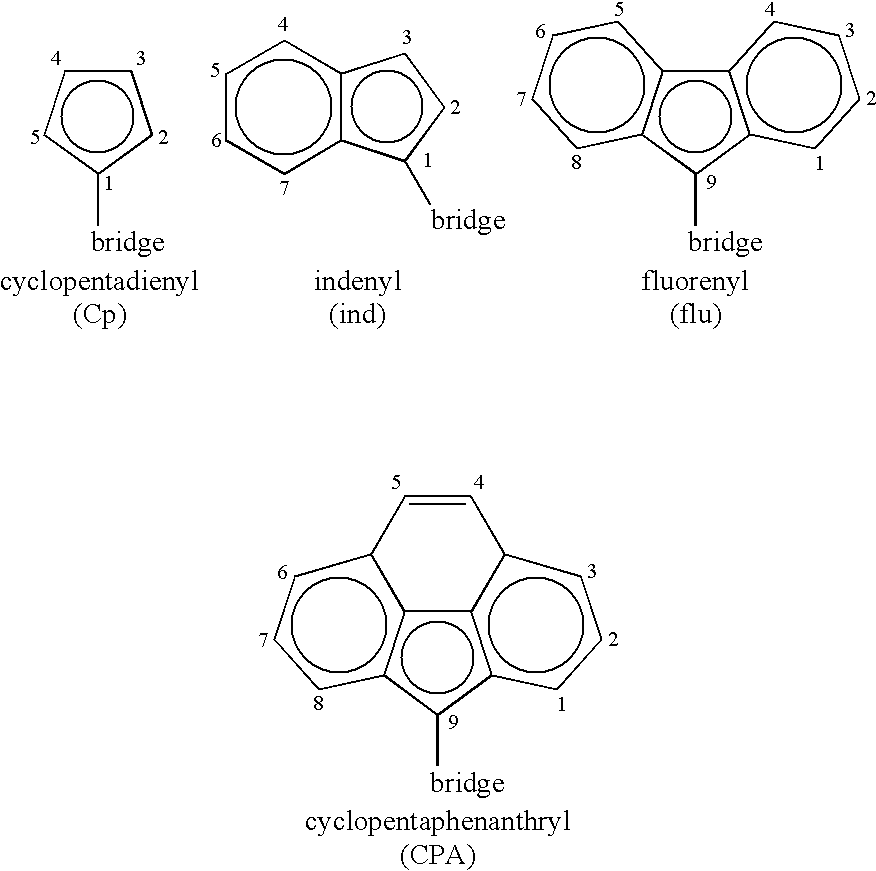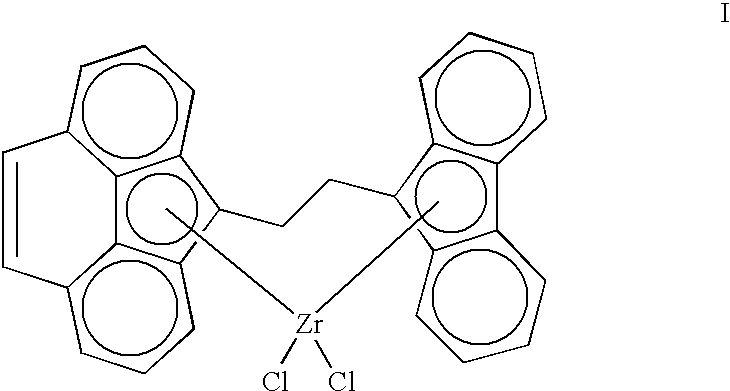Elastic polypropylenes and catalysts for their manufacture
a technology of polypropylene and catalyst, applied in the direction of organic chemistry, group 4/14 element organic compounds, silicon organic compounds, etc., can solve the problems of general correlation, no reliable, and difficult to predict the exact effect of catalyst structure change on catalyst activity and polymer stereoregularity, so as to facilitate the flow and extrusion of the catalyst, the effect of reducing the glass transition temperatur
- Summary
- Abstract
- Description
- Claims
- Application Information
AI Technical Summary
Benefits of technology
Problems solved by technology
Method used
Image
Examples
example 1
2-(9-fluorenyl)ethyl trifluoromethane sulfonate
A 2.5 M solution of n-butyllithium in hexane was added with stirring to 5 g 2-(9-fluorenyl)ethanol, flu-CH.sub.2 --CH.sub.2 --OH (prepared by the method disclosed in Organometallics 13, 647 (1994)), in 90 mL toluene. Addition was terminated when the reaction mixture became light orange; about 10 mL was required. The resulting solution of Li{flu-CH.sub.2 --CH.sub.2 --O} was cooled in a dry ice-acetone bath and 3.8 g trifluoromethanesulfonyl fluoride, CF.sub.3 SO.sub.2 F (prepared according to U.S. Pat. No. 2,732,398, Example 1), was added by vacuum transfer. After warming to room temperature, any unreacted CF.sub.3 SO.sub.2 F was removed by pumping. The desired compound was obtained as a colorless oil, 7.7 g (95%) by filtration of the reaction mixture followed by evaporation of solvents. Spectroscopic and chemical analysis confirmed the identity of the desired compound.
example 2
{flu-C.sub.2 H.sub.4 -ind}
1-(9-fluorenyl)-2-(1-indenyl)ethane
To a solution of 21.0 g 2-(9-fluorenyl)ethanol, in 495 mL toluene was added dropwise with stirring 40 mL of a 2.5M solution of n-butyllithium in hexane. The resulting solution of Li{flu-CH.sub.2 --CH.sub.2 --O} was cooled to below -25.degree. C. Then, 16.7 g CF.sub.3 SO.sub.2 F was condensed into the reaction mixture. The temperature was allowed to rise to 25.degree. C. and the reaction mixture was stirred for 6 h. Unreacted CF.sub.3 SO.sub.2 F was removed by pumping about 10 mL of liquid into a dry ice-cooled trap. To the solution of flu-CH.sub.2 --CH.sub.2 --OSO.sub.2 CF.sub.3 thus obtained was added a solution of 0.1 mole indenyllithium in 100 mL diethyl ether. After stirring for 12 h, solvents were removed under vacuum and the residue recrystallized in air from boiling heptane. The yield of white microcrystalline solid, mp 79-80.degree. C., was 8.9 g (29%). Spectroscopic and chemical analysis confirmed the identity of ...
example 3
{flu-C.sub.2 H.sub.4 -ind}ZrCl.sub.2 (designated 18N in Table 1, below)
A solution of 1.54 g 1-(9-fluorenyl)-2-(1-indenyl)ethane (Example 2) in 70 mL diethyl ether was treated with 4 mL 2.5M n-butyllithium in hexane. The resulting orange solution was stirred overnight, after which solvents were pumped away on a vacuum line. Zirconium chloride (1.17 g) and 75 mL hexane were added. The reaction mixture was vigorously stirred for 18 h then filtered. The solids were extracted with 350 mL dichloromethane. The filtered extract was evaporated and the residue slurried with 10 mL portions of 1:1 (v / v) dichloromethane-hexane to produce 0.61 g (26%) bright orange, powdery product that was collected on a filter and vacuum dried. Spectroscopic and chemical analysis confirmed the identity of the desired compound.
PUM
| Property | Measurement | Unit |
|---|---|---|
| Percent by mass | aaaaa | aaaaa |
| Percent by mass | aaaaa | aaaaa |
| Percent by mass | aaaaa | aaaaa |
Abstract
Description
Claims
Application Information
 Login to View More
Login to View More - R&D
- Intellectual Property
- Life Sciences
- Materials
- Tech Scout
- Unparalleled Data Quality
- Higher Quality Content
- 60% Fewer Hallucinations
Browse by: Latest US Patents, China's latest patents, Technical Efficacy Thesaurus, Application Domain, Technology Topic, Popular Technical Reports.
© 2025 PatSnap. All rights reserved.Legal|Privacy policy|Modern Slavery Act Transparency Statement|Sitemap|About US| Contact US: help@patsnap.com



